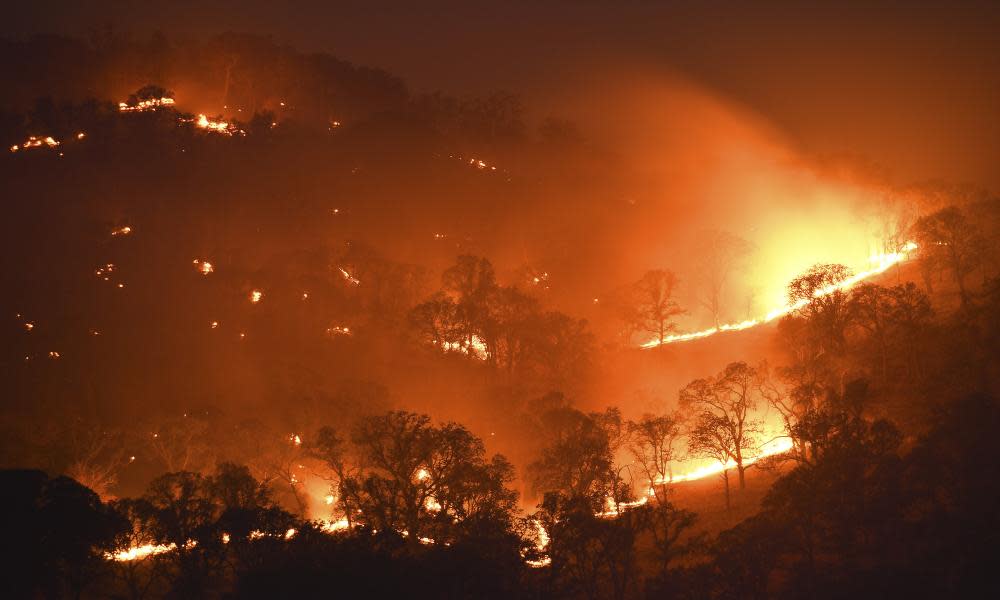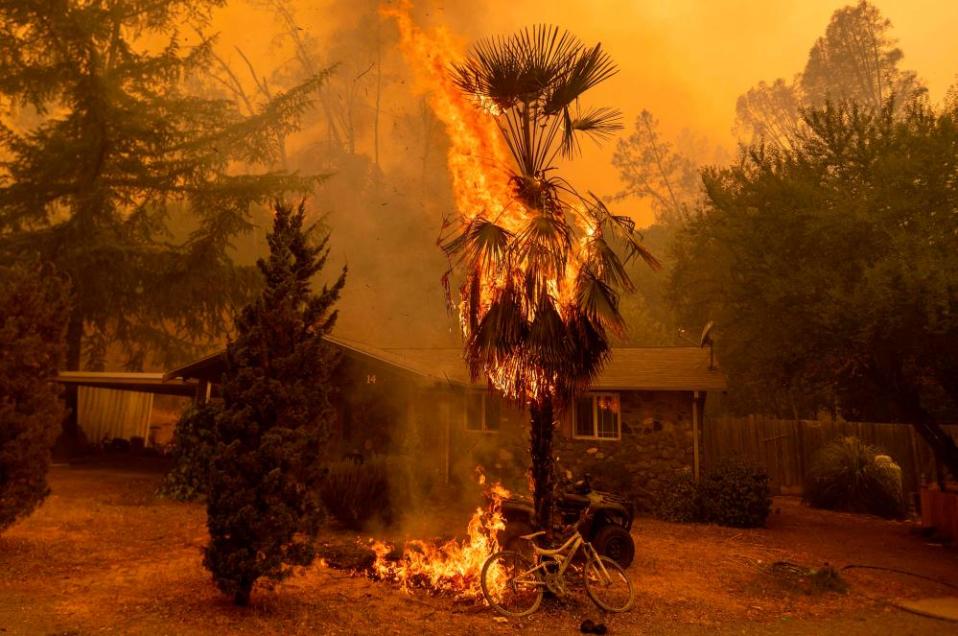California governor declares state of emergency as dozens of wildfires rage

California’s governor has declared a state of emergency as the state battles dozens of wildfires amid a historic heatwave.
“We are deploying every resource available to keep communities safe as California battles fires across the state during these extreme conditions,” said Gavin Newsom, the state governor, on Tuesday. “California and its federal and local partners are working in lockstep to meet the challenge and remain vigilant in the face of continued dangerous weather conditions.”
Fires of varying size are currently burning across the state including in Sonoma, San Mateo, Napa, Butte, Nevada and Monterey counties. Evacuations were in effect or growing in the Napa county wine country north of San Francisco Bay, near Salinas in Monterey county, around Oroville Dam north of Sacramento and near the Nevada state line north of Lake Tahoe.
Several fires had been sparked by lightening strikes during unusual thunderstorms prompted by the extreme heatwave, which has sent temperatures soaring into the triple digits.
Related: Death Valley temperature rises to 54.4C – possibly the hottest ever reliably recorded
One of the largest – the SCU Lightning Complex fire, comprised of fires burning in several Bay Area counties – has so far consumed 25,000 acres and remains 0% contained.
A fire in Napa county was burning close to remote grape-growing properties owned by Villa Del Lago Winery.
“Our vineyard workers had to evacuate very quickly. And we heard this morning that there was zero containment, so that’s scary. It’s very steep, so I know it’s hard for firefighters to get up there,” said Dawn Phillips, who works in customer service for the winery.
Firefighters toiled in oppressive heat as the fires burned, posing threats to homes, forcing evacuations and fouling the air with smoke far beyond the largely rural or wilderness areas where flames fed on very dry vegetation.
Michelle Leopold, co-owner of six Ace hardware stores in the San Francisco Bay Area, said she sold 56 wading pools, two air conditioning units and a number of generators Saturday. She said she’s grateful her employees have not contracted the coronavirus and her stores are even hiring.
“You look at the blessings in this crazy time because there’s not much else to look at,” she said, laughing.
In southern California, evacuations continued for a week-old fire in the mountains of northern Los Angeles county. Dynamic weather churned up thunderstorms bringing the double threat of more lightning-sparked fires and flash floods.

Meanwhile, California’s power grid operators are under pressure to avoid more power blackouts as an ongoing heat wave stresses the electrical system. Thousands lost electricity over the weekend as the system strained under high demand, a situation Newsom described as “unacceptable”.
The California Independent System Operator had warned Monday that as many as 3.3m homes and businesses would be affected by an evening emergency order that would have required utilities to stage rotating, two-hour outages. But the order never was issued and the warning was canceled.
Pleas for people to leave their air conditioners at higher temperatures and avoid using washing machines and other major appliances seemed to have worked. “Thank you for conserving,” California ISO said in a tweet.
However, grid managers warned that the threat of outages remained as temperatures were expected to hit triple digits again in many areas of the state. The National Weather Service said it may take until Friday or Saturday before excess heat watches and warnings ease.
Scorching weather has hit other western states, making it harder for California to import extra power.
“What we have is a situation where the entire region is more than hot, it’s extremely hot,” said Steve Berberich, California ISO’s president and CEO. “We can’t get the energy that we would normally get from out of state because it’s being used to serve loads natively. That would probably account for another 4,000 to 5,000 megawatts and could have very well have closed the gap.”
Related: Governor demands investigation after Californians left without power in extreme heat
California ISO has struggled to reduce the electrical demand since last Friday, when it issued the first rolling blackouts in nearly 20 years. The three biggest utilities – Pacific Gas & Electric, Southern California Edison and San Diego Gas & Electric – turned off power to more than 410,000 homes and businesses for about an hour at a time. A second but shorter outage hit Saturday evening, affecting more than 200,000 customers.
Bonnie Wikler, 66, worried about her husband, who is recovering from open heart surgery. She said it was very stressful to lose power twice over the weekend at their home in Coalinga, a city in central California where temperatures reached 109F (43C).
They thought about driving somewhere but were too afraid of coronavirus exposure, so they stayed home and cooled off with ice water, she said.
“If there was a fire or an earthquake, I would understand, but to cut power without letting you know, it just seems outlandish to me,” Wikler said.

